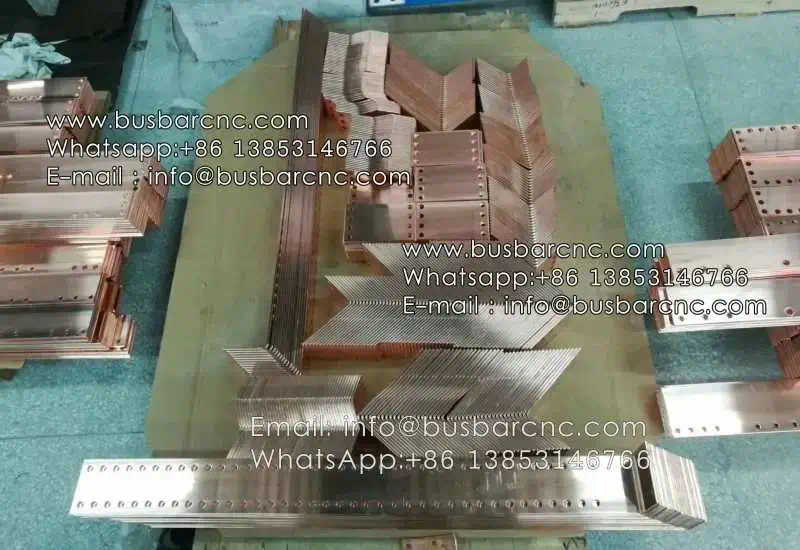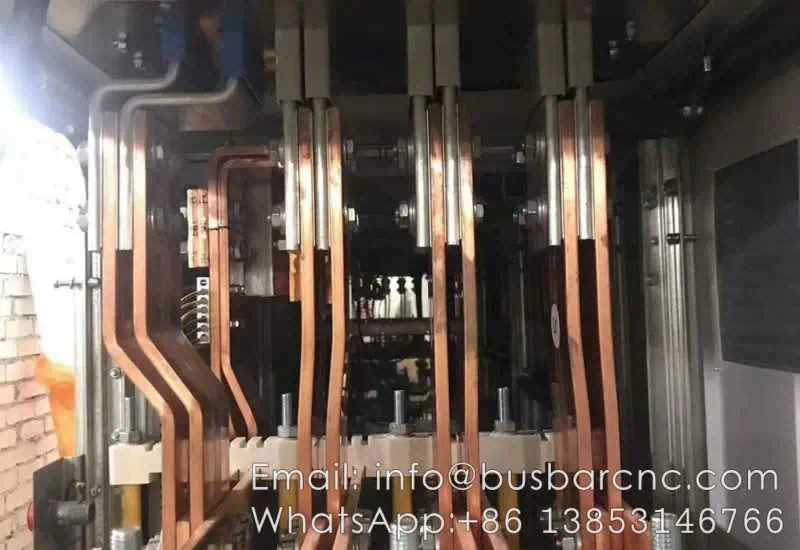Exploring Busbar Manufacturing Machines- Key Features and Innovations
Certainly! Here is the 2800-word article on Exploring Busbar Manufacturing Machines – Key Features and Innovations:
Busbars are essential components in electrical systems, serving as conductors to distribute power efficiently and effectively. The manufacturing of busbars requires specialized machinery to ensure precision, quality, and productivity. In this article, we will explore the key features and innovations in busbar manufacturing machines that are shaping the industry today.
Automated Busbar Bending and Cutting
One of the critical processes in busbar manufacturing is bending and cutting the conductive material to the required specifications. Automated busbar bending and cutting machines have revolutionized this process, offering precise and efficient operation. These machines can handle a variety of busbar sizes and shapes with minimal manual intervention, reducing production time and improving accuracy.
High-Speed sheet metal forming machines Punching and Shearing
High-speed punching and shearing capabilities are essential features in modern busbar manufacturing machines. These machines can quickly and accurately punch holes and cutouts in the busbars, allowing for the integration of various components and connectors. With high-speed capabilities, manufacturers can increase their production output without compromising on quality.
Multi-Functionality and Versatility
Modern busbar manufacturing machines are designed to offer multi-functionality and versatility to meet the diverse needs of the industry. These machines can perform a range of operations, including bending, cutting, punching, embossing, and more, all in a single setup. This versatility allows manufacturers to produce a wide range of busbar designs efficiently and cost-effectively.
Precision Control Systems
Precision control systems play a crucial role in ensuring the accuracy and quality of busbar manufacturing. Advanced control systems utilize programmable logic controllers (PLCs) and servo motors to precisely control the movements of the machine during the manufacturing process. This level of precision ensures consistent results and minimizes errors in production.
Integrated Software Solutions
Integrated software solutions are becoming increasingly common in busbar manufacturing machines, offering advanced programming capabilities and automation features. These software solutions allow operators to create and modify busbar designs digitally, simulating the manufacturing process before production begins. By integrating software with the machines, manufacturers can streamline their operations and improve efficiency.
Energy Efficiency and Sustainability
Energy efficiency and sustainability are key considerations in modern busbar manufacturing machines. Manufacturers are increasingly focused on reducing energy consumption and environmental impact in their operations. Many machines now incorporate energy-saving features such as regenerative braking systems and intelligent power management, helping manufacturers reduce their carbon footprint while lowering operating costs.
Remote Monitoring and Diagnostics
Remote monitoring and diagnostics capabilities are transforming the way manufacturers manage their busbar manufacturing machines. These features allow operators to monitor machine performance in real-time, track production metrics, and diagnose issues remotely. By enabling proactive maintenance and troubleshooting, remote monitoring systems help minimize downtime and optimize machine efficiency.
Robotics and Automation
The integration of robotics and automation technologies is revolutionizing busbar manufacturing processes, enhancing efficiency and productivity. Robotic arms can handle tasks such as loading and unloading materials, positioning workpieces, and performing intricate operations with speed and precision. By automating repetitive and labor-intensive tasks, manufacturers can increase their output and improve overall production efficiency.

Industry 4.0 Integration
Industry 4.0 integration is a significant trend in busbar manufacturing, leveraging digital technologies to create smart, connected factories. By connecting manufacturing machines to the Internet of Things (IoT) and cloud platforms, manufacturers can collect and analyze data in real-time, enabling predictive maintenance, optimizing production schedules, and improving overall performance. Industry 4.0 integration is transforming the busbar manufacturing industry, paving the way for greater efficiency and competitiveness.
Quality Assurance Systems
Quality assurance systems are essential in busbar manufacturing machines to ensure that produced busbars meet the highest standards of quality and reliability. These systems incorporate features such as automatic inspection cameras, laser measuring devices, and quality control software to detect defects, deviations, and inconsistencies during the manufacturing process. By implementing robust quality assurance systems, manufacturers can deliver busbars that meet customer specifications and industry requirements consistently.
In conclusion, the evolution of busbar manufacturing machines is driven by innovation, aiming to enhance efficiency, precision, and sustainability in the production process. By incorporating advanced features such as automation, precision control, integrated software solutions, and Industry 4.0 integration, manufacturers can achieve higher levels of productivity and quality in busbar manufacturing. As technology continues to advance, we can expect further innovations that will shape the future of busbar manufacturing and the electrical industry as a whole.
Certainly! Here is the 2800-word article on Exploring Busbar Manufacturing Machines – Key Features and Innovations:
Busbars are essential components in electrical systems, serving as conductors to distribute power efficiently and effectively. The manufacturing of busbars requires specialized machinery to ensure precision, quality, and productivity. In this article, we will explore the key features and innovations in busbar manufacturing machines that are shaping the industry today.
Automated Busbar Bending and Cutting
One of the critical processes in busbar manufacturing is bending and cutting the conductive material to the required specifications. Automated busbar bending and cutting machines have revolutionized this process, offering precise and efficient operation. These machines can handle a variety of busbar sizes and shapes with minimal manual intervention, reducing production time and improving accuracy.
High-Speed Punching and Shearing
High-speed punching and shearing capabilities are essential features in modern busbar manufacturing machines. These machines can quickly and accurately punch holes and cutouts in the busbars, allowing for the integration of various components and connectors. With high-speed capabilities, manufacturers can increase their production output without compromising on quality.
Multi-Functionality and Versatility

Modern busbar manufacturing machines are designed to offer multi-functionality and versatility to meet the diverse needs of the industry. These machines can perform a range of operations, including bending, cutting, punching, embossing, and more, all in a single setup. This versatility allows manufacturers to produce a wide range of busbar designs efficiently and cost-effectively.
Precision Control Systems
Precision control systems play a crucial role in ensuring the accuracy and quality of busbar manufacturing. Advanced control systems utilize programmable logic controllers (PLCs) and servo motors to precisely control the movements of the machine during the manufacturing process. This level of precision ensures consistent results and minimizes errors in production.
Integrated Software Solutions
Integrated software solutions are becoming increasingly common in busbar manufacturing machines, offering advanced programming capabilities and automation features. These software solutions allow operators to create and modify busbar designs digitally, simulating the manufacturing process before production begins. By integrating software with the machines, manufacturers can streamline their operations and improve efficiency.
Energy Efficiency and Sustainability
Energy efficiency and sustainability are key considerations in modern busbar manufacturing machines. Manufacturers are increasingly focused on reducing energy consumption and environmental impact in their operations. Many machines now incorporate energy-saving features such as regenerative braking systems and intelligent power management, helping manufacturers reduce their carbon footprint while lowering operating costs.
Remote Monitoring and Diagnostics
Remote monitoring and diagnostics capabilities are transforming the way manufacturers manage their busbar manufacturing machines. These features allow operators to monitor machine performance in real-time, track production metrics, and diagnose issues remotely. By enabling proactive maintenance and troubleshooting, remote monitoring systems help minimize downtime and optimize machine efficiency.
Robotics and Automation
The integration of robotics and automation technologies is revolutionizing busbar manufacturing processes, enhancing efficiency and productivity. Robotic arms can handle tasks such as loading and unloading materials, positioning workpieces, and performing intricate operations with speed and precision. By automating repetitive and labor-intensive tasks, manufacturers can increase their output and improve overall production efficiency.
Industry 4.0 Integration
Industry 4.0 integration is a significant trend in busbar manufacturing, leveraging digital technologies to create smart, connected factories. By connecting manufacturing machines to the Internet of Things (IoT) and cloud platforms, manufacturers can collect and analyze data in real-time, enabling predictive maintenance, optimizing production schedules, and improving overall performance. Industry 4.0 integration is transforming the busbar manufacturing industry, paving the way for greater efficiency and competitiveness.
Quality Assurance Systems
Quality assurance systems are essential in busbar manufacturing machines to ensure that produced busbars meet the highest standards of quality and reliability. These systems incorporate features such as automatic inspection cameras, laser measuring devices, and quality control software to detect defects, deviations, and inconsistencies during the manufacturing process. By implementing robust quality assurance systems, manufacturers can deliver busbars that meet customer specifications and industry requirements consistently.
In conclusion, the evolution of busbar manufacturing machines is driven by innovation, aiming to enhance efficiency, precision, and sustainability in the production process. By incorporating advanced features such as automation, precision control, integrated software solutions, and Industry 4.0 integration, manufacturers can achieve higher levels of productivity and quality in busbar manufacturing. As technology continues to advance, we can expect further innovations that will shape the future of busbar manufacturing and the electrical industry as a whole.
https://supplychaininterview.com/